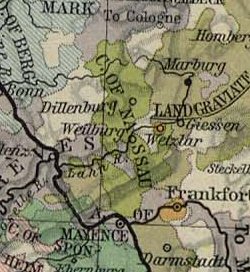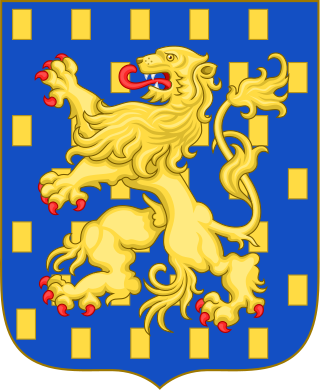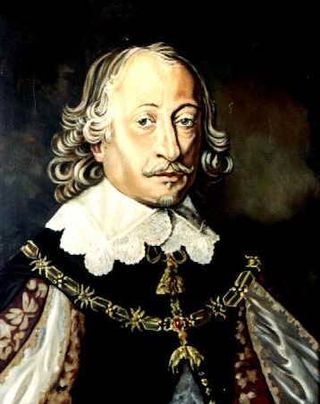
The County of Nassau was a German state within the Holy Roman Empire and later part of the German Confederation. Its ruling dynasty, the male line of which is now extinct, was the House of Nassau.

The House of Nassau is a diversified aristocratic dynasty in Europe. It is named after the lordship associated with Nassau Castle, located in present-day Nassau, Rhineland-Palatinate, Germany. With the fall of the Hohenstaufen in the first half of the 13th century royal power within Franconia evaporated and the former stem duchy fragmented into separate independent states. Nassau emerged as one of those independent states as part of the Holy Roman Empire. The lords of Nassau were originally titled "Count of Nassau", subject only to the Emperor, and then elevated to the princely class as "Princely Counts". Early on they divided into two main branches: the elder (Walramian) branch, that gave rise to the German king Adolf, and the younger (Ottonian) branch, that gave rise to the Princes of Orange and the monarchs of the Netherlands.
Otto I of Nassau, German: Otto I. von Nassau was Count of Nassau and is the ancestor of the Ottonian branch of the House of Nassau.
Georg Ernst of Limburg Stirum, count of Limburg Stirum, count of Bronckhorst, Lord of Wisch, Lichtenvoorde and Wildenborch, son of Jobst of Limburg.

The Counts of Vianden, ancestors of the House of Orange-Nassau, were associated with the castle of Vianden in Luxembourg.

John VIII, Count of Nassau-Siegen was a German nobleman and militarist of the 17th century.

Count John IV of Nassau-Siegen, German: Johann IV. Graf von Nassau-Siegen, official titles: Graf zu Nassau, Vianden und Diez, Herr zu Breda, was since 1442 Count of Nassau-Siegen, of Vianden and of half Diez, and Lord of Breda and of the Lek. He descended from the Ottonian Line of the House of Nassau.

Count Otto II of Nassau-Siegen, German: Otto II. Graf von Nassau-Siegen, was since 1343 Count of Nassau-Siegen. He descended from the Ottonian Line of the House of Nassau.

Henry I of Nassau-Siegen, German: Heinrich I. von Nassau-Siegen was Count of Nassau-Siegen, a part of the County of Nassau, and ancestor of the House of Nassau-Siegen. He comes from the Ottonian branch of the House of Nassau.

John Louis of Nassau-Hadamar, and also known in German as Johann Ludwig, was a German nobleman and member of the House of Nassau who is best known for his role as an aide to the head of the imperial delegation for the Peace of Westphalia, Count Maximilian von Trautmansdorff.

Louis Henry of Nassau-Dillenburg, was Count, and from 1654 Prince of Nassau-Dillenburg. During the Thirty Years' War, he was a senior officer. He climbed to the rank of Major General. Before 1635, he served on the Protestant side; after 1635, he served in the imperial army.
Count Louis I of Nassau-Weilburg was a son of Count John III of Nassau-Weilburg and his wife, Elisabeth of Hesse. In 1492, Louis I succeeded his grandfather Philip II as Count of Nassau-Weilburg, because his father had already died in 1480.

Count George of Nassau-Beilstein, later also Count of Nassau-Dillenburg, was the third son of Count John VI "the Elder" of Nassau-Dillenburg (1536–1606) from his first marriage with Landgravine Elisabeth of Leuchtenberg.
Katharina of Nassau-Beilstein was Countess of Hanau by marriage to Reinhard II, Count of Hanau, and regent of Hanau during the minority of her son Reinhard III from 1452 until 1458.
Henry II, Count of Nassau-Beilstein was the eldest son of Henry I and his wife, Imagina of Westerburg. He succeeded his father in 1388 as Count of Nassau-Beilstein and ruled jointly with his younger brother Reinhard.

Count Henry II of Nassau-Siegen, German: Heinrich II. Graf von Nassau-Siegen, official titles: Graf zu Nassau, Vianden und Diez, Herr zu Breda, was since 1442 Count of Nassau-Siegen, of Vianden and of half Diez. He descended from the Ottonian Line of the House of Nassau.
Henry I, Count of Nassau-Beilstein (1307-1388) was a son of Henry I of Nassau-Siegen and his wife, Adelaide of Heinsberg-Blankenberg. His parents had initially destined him for an ecclesiastical career. However, he later married Meyna of Westerburg and after his father's death became the first count of Nassau-Beilstein.
John III, Count of Nassau-Beilstein was a son of John II and his wife Maria of Solms-Braunfels.
Emicho I, Count of Nassau-Hadamar, was the second son of Count Otto I of Nassau and his wife Agnes, the daughter of Count Emich IV of Leiningen-Landeck. Emicho was the founder of the elder line of Nassau-Hadamar. He was a cousin of King Adolf of Germany. He and his brother Henry fought on Adolf's side in the Battle of Göllheim on 2 July 1298.
John, Count of Nassau-Dillenburg was the third son of Count Otto I of Nassau and his wife Agnes, daughter of Count Emich IV of Leiningen-Landeck. John was a first cousin of King Adolf of the Romans.










